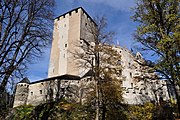| (Princely) County of Görz (Gefürstete) Grafschaft Görz | ||||||
| State of the Holy Roman Empire | ||||||
| ||||||
| ||||||
Görz territories (in white), late 15th century
| ||||||
| Capital | Gorizia | |||||
| Government | Principality | |||||
| Historical era | Middle Ages | |||||
| - | Meinhard, Count of Gorizia |
1127 | ||||
| - | Meinhard III inherited Tyrol |
1253 | ||||
| - | Raised to principality | 1365 | ||||
| - | Bequeathed to House of Habsburg |
1500 | ||||
| - | Joined Austrian Circle | 1512 | ||||
| - | Reunited with Gradisca | 1747 | ||||
The County of Gorizia (German: Grafschaft Görz, Italian: Contea di Gorizia, Slovene: Goriška grofija, Friulian: Contee di Gurize) was a county based around the town of Gorizia in the present-day Friuli-Venezia Giulia region of north-eastern Italy.
History[]
Count Meinhard, a descendant of the Meinhardiner noble family with possessions around Lienz in the Duchy of Bavaria, is mentioned as early as 1107. As a vogt official of the Patriarchs of Aquileia, he was enfeoffed with large estates in the former March of Friuli, including the town of Gorizia, and from 1127 on called himself a Graf von Görz.

Görz Castle
The borders of the county changed frequently in the following four centuries, due to frequent wars with Aquileia and other counties, but also to the subdivision of the territory in two main nuclei: one around the Bavarian ancestral seat around Lienz on the upper Drava up to Innichen in the Puster Valley, the other centered on Gorizia in Friuli itself.
Gorizia-Tyrol[]
Meinhard's descendant Count Meinhard III of Görz, a follower of the Hohenstaufen emperor Frederick II, upon the extinction of the House of Babenberg was appointed administrator of Styria in 1248. He campaigned the adjacent Duchy of Carinthia but was defeated by the troops of Duke Bernhard von Spanheim and his son Archbishop Philip of Salzburg at Greifenburg in 1252. Nevertheless the county reached the apex of its power, when Meinhard III inherited County of Tyrol (as Meinhard I) from his father-in-law Count Albert IV one year later.
After Count Meinhard III had died in 1258, his sons at first ruled jointly until in 1271 they divided their heritage: While the elder Meinhard IV took the comital Tyrolean lands west of the Puster Valley, his brother Albrecht (c1260-1304) retained the Meinhardiner ancestral lands around Lienz and Gorizia. After his death, the County of Görz was again partitoned among his sons into the "inner county" at Görz, ruled by Heinrich III, and the "outer county" around Lienz und Albrecht II. When Count Henry III was assassinated in 1323, the Gorizia lands were shattered into four countries. The Counts of Gorizia temporarily controlled the Italian March of Treviso (Marca Trevigiana) and the remains of the Istrian march around Pazin (Mitterburg), which Count Albrecht III of Görz bequeathed to the House of Habsburg in 1365.

Bruck Castle, Lienz
In 1365 Count Meinhard VI of Görz was granted the princely title by the Luxemborg emperor Charles IV, the county was thereon called Gefürstete Grafschaft Görz. The Meinhardiner nevertheless suffered a steep decline under their powerful neighbours, the Austrian lands of the Habsburg dynasty and the Republic of Venice. After the Habsburgs had acquired the Carinthian duchy with the March of Carniola in 1335 and the County of Tyrol in 1363, the remaining Gorizia lands of Lienz were a thorn in their side, separating the dynasty's "hereditary lands". Venice had conquered the former Patriarchate territories in Friuli, which were incorporated into the Domini di Terraferma by 1434. The Council of Ten strived for the adjacent "inner county" lands around Gorizia up to the Venetian Stato da Màr territories in Istria. Due to the pressure, the counts of Görz took their residence at Bruck Castle in Lienz.
Habsburg[]
In 1429 the county was reunited under the single rule of Count Heinrich VI. His son, the last count Leonhard, died in 1500 and despite claims raised by Venice, according to a contract of inheritance the county fell to the Habsburg emperor Maximilian I.
While the Lienz area was administrated with the Tyrolean crown land, Gorizia until 1747 formed an Imperial State of the Holy Roman Empire ruled by the Inner Austrian Archdukes as part of the Austrian Circle, governed by a capitano. Its territory included the valley of Isonzo River down to Aquileia, the area of Cormons and Duino, and the former Venetian fortress of Gradisca, which was conquered by Imperial troops in 1511. In 1647 Emperor Ferdinand III separated the "County of Gradisca" from Gorizia for his courtier Johann Anton von Eggenberg, until in 1747 both were again merged to form the Princely County of Gorizia and Gradisca.
See also[]
- House of Gorizia
- History of Gorizia
- Austrian Empire
- History of Slovenia
External links[]
| |||||||||||||||||




